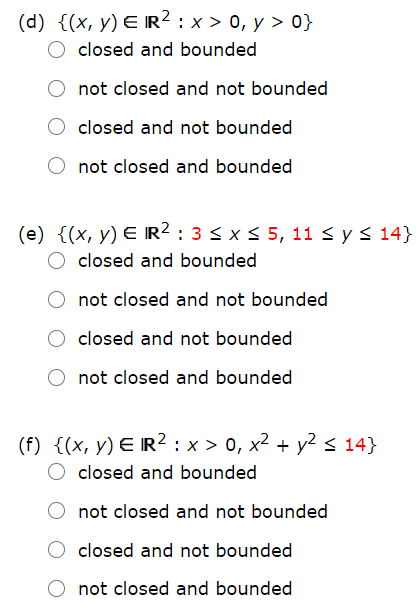(d) {(x, y) E IR² : x > 0, y > 0} closed and bounded not closed and not bounded closed and not bounded not closed and bounded (e) {(x, y) E IR2 : 3 < xs 5, 11 s ys 14) closed and bounded not closed and not bounded closed and not bounded not closed and bounded (f) {(x, y) E IR² : x > 0, x² + y2 s 14} closed and bounded not closed and not bounded closed and not bounded not closed and bounded
(d) {(x, y) E IR² : x > 0, y > 0} closed and bounded not closed and not bounded closed and not bounded not closed and bounded (e) {(x, y) E IR2 : 3 < xs 5, 11 s ys 14) closed and bounded not closed and not bounded closed and not bounded not closed and bounded (f) {(x, y) E IR² : x > 0, x² + y2 s 14} closed and bounded not closed and not bounded closed and not bounded not closed and bounded
Elements Of Modern Algebra
8th Edition
ISBN:9781285463230
Author:Gilbert, Linda, Jimmie
Publisher:Gilbert, Linda, Jimmie
Chapter5: Rings, Integral Domains, And Fields
Section5.4: Ordered Integral Domains
Problem 8E: If x and y are elements of an ordered integral domain D, prove the following inequalities. a....
Related questions
Question

Transcribed Image Text:(d) {(x, y) E IR² : x > 0, y > 0}
closed and bounded
not closed and not bounded
closed and not bounded
not closed and bounded
(e) {(x, y) E IR2 : 3 < xs 5, 11 s ys 14)
closed and bounded
not closed and not bounded
closed and not bounded
not closed and bounded
(f) {(x, y) E IR² : x > 0, x² + y2 s 14}
closed and bounded
not closed and not bounded
closed and not bounded
not closed and bounded
Expert Solution
This question has been solved!
Explore an expertly crafted, step-by-step solution for a thorough understanding of key concepts.
This is a popular solution!
Trending now
This is a popular solution!
Step by step
Solved in 2 steps with 2 images

Recommended textbooks for you

Elements Of Modern Algebra
Algebra
ISBN:
9781285463230
Author:
Gilbert, Linda, Jimmie
Publisher:
Cengage Learning,

Algebra & Trigonometry with Analytic Geometry
Algebra
ISBN:
9781133382119
Author:
Swokowski
Publisher:
Cengage

Elements Of Modern Algebra
Algebra
ISBN:
9781285463230
Author:
Gilbert, Linda, Jimmie
Publisher:
Cengage Learning,

Algebra & Trigonometry with Analytic Geometry
Algebra
ISBN:
9781133382119
Author:
Swokowski
Publisher:
Cengage